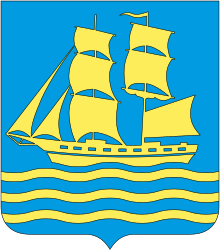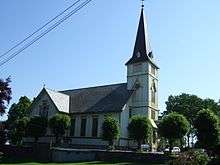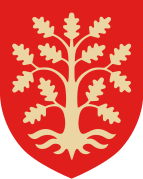Grimstad
Grimstad (![]()
Grimstad kommune | |
|---|---|
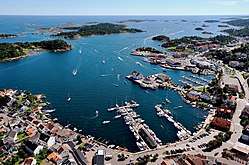 View of Grimstad harbour | |
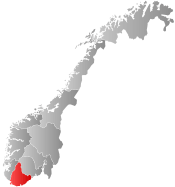 Agder within Norway | |
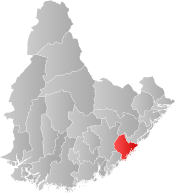 Grimstad within Agder | |
| Coordinates: 58°21′07″N 08°32′40″E | |
| Country | Norway |
| County | Agder |
| District | Sørlandet |
| Administrative centre | Grimstad |
| Government | |
| • Mayor (2015) | Beate Skretting (H) |
| Area | |
| • Total | 303.58 km2 (117.21 sq mi) |
| • Land | 272.36 km2 (105.16 sq mi) |
| • Water | 31.22 km2 (12.05 sq mi) |
| Area rank | 276 in Norway |
| Population (2017) | |
| • Total | 22,692 |
| • Rank | 50 in Norway |
| • Density | 83.3/km2 (216/sq mi) |
| • Change (10 years) | 16.2% |
| Demonym(s) | Grimstadmann (m) Grimstadkvinne (f) Grimstadfolk[1] |
| Time zone | UTC+01:00 (CET) |
| • Summer (DST) | UTC+02:00 (CEST) |
| ISO 3166 code | NO-4202 |
| Official language form | Bokmål[2] |
| Website | www |
The municipality is centered around the little maritime town of Grimstad which is surrounded by many small islands (Skjærgård). There is a harbor, a long pedestrian shopping street, a small market square, Grimstad Church, and a museum dedicated to the early life of Henrik Ibsen, who served as an apprentice to Grimstad’s local pharmacist Reimann, from 1844 to 1847, before leaving Grimstad in 1850. Ibsen's intimate knowledge of the local people and surroundings can be seen in his poem Terje Vigen.[3] The majority of the inhabitants live in and around the town, while the rest of the municipality is rural and heavily forested.
The 304-square-kilometre (117 sq mi) municipality is the 276th largest by area out of the 422 municipalities in Norway. Grimstad is the 50th most populous municipality in Norway with a population of 22,692. The municipality's population density is 83.3 inhabitants per square kilometre (216/sq mi) and its population has increased by 16.2% over the last decade.[4]
General information
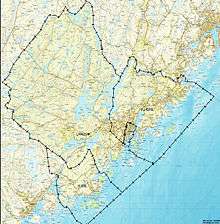
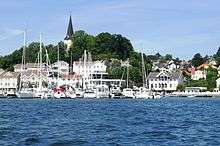
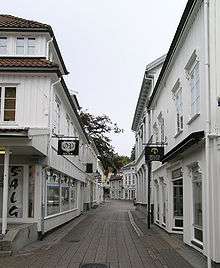
The town of Grimstad was established as a municipality on 1 January 1838 (see formannskapsdistrikt). On 1 January 1878, part of the neighboring municipality of Fjære (population: 948) was transferred to Grimstad. Again, on 1 January 1960, another part of Fjære (pop: 344) was transferred to Grimstad. On 1 January 1971, the rural municipalities of Fjære (pop: 6,189) and Landvik (pop: 2,781) were merged with the town of Grimstad (pop: 2,794) to form a significantly larger municipality of Grimstad with a total population of 11,764 at the time of the merger.[5]
Name
The city's name was originally Grømstad, when Norway belonged to the Danish kingdom. The name was misunderstood and became Grimstad during the registration of Norwegian cities and small places. The site of the town was originally the port (Old Norse: stoð) of the old Grøm farm. The exact meaning of the name Grøm is uncertain, but it is derived from a river name Gró or Gróa which means "the growing one".[6]
Coat-of-arms
The coat-of-arms were granted in 1899 and were based upon a seal of the city dating back to 1847. The blue and yellow arms show a brig as a symbol for the importance of fishing and shipping to the city.[6][7]
Churches
The Church of Norway has four parishes (sokn) within the municipality of Grimstad. It is part of the Vest-Nedenes deanery in the Diocese of Agder og Telemark.
| Parish (Sokn) | Church Name | Location of the Church | Year Built |
|---|---|---|---|
| Eide | Eide Church | Eide | 1795 |
| Fjære | Fevik Church | Fevik | 1976 |
| Fjære Church | Fjære | c. 1150 | |
| Grimstad | Grimstad Church | Grimstad | 1881 |
| Landvik | Landvik Church | Roresand | 1825 |
| Østerhus Church | Østerhus | 1980 |
History
Grimstad lies within the boundaries of the ancient parish of Fjære. It is reportedly first mentioned as a harbor in the 16th century. Eight years after he was deposed, Christian II of Denmark–Norway (1513–1523) attempted to recover his kingdoms. A tempest scattered his fleet off the Norwegian coast, and on 24 October 1531, they took refuge at Grimstad. On 1 July 1532, he surrendered to his rival, King Frederick I of Denmark, in exchange for a promise of safe conduct. King Frederick failed to honor his promise and imprisoned Christian until he died.[8]
An inn is recorded at Grimstad as early as 1607. In 1622, Grimstad became a recognized harbor under the town of Arendal. By 1747, Grimstad was identified as a sailing community and a recognized haunt of smugglers. During the Napoleonic Wars, England blockaded Norway. In 1811, an English brig entered the harbor to capture blockade runners, but was vigorously repulsed and did not return.
John Frederik Classen, who owned the Frolands Værk (an ironworks), obtained concessions to export and import through Grimstad and bypass Arendal with its customs dues. Grimstad was awarded market town status in 1816.
The Nørholm farm in Grimstad was the home of Knut Hamsun in the early 20th century.
Government
All municipalities in Norway, including Grimstad, are responsible for primary education (through 10th grade), outpatient health services, senior citizen services, unemployment and other social services, zoning, economic development, and municipal roads. The municipality is governed by a municipal council of elected representatives, which in turn elect a mayor.
Municipal council
The municipal council (Kommunestyre) of Grimstad is made up of 35 representatives that are elected to four year terms. Currently, the party breakdown is as follows:[9]
| Party Name (in Norwegian) | Number of representatives | |
|---|---|---|
| Labour Party (Arbeiderpartiet) | 9 | |
| Progress Party (Fremskrittspartiet) | 6 | |
| Green Party (Miljøpartiet De Grønne) | 1 | |
| Conservative Party (Høyre) | 6 | |
| Christian Democratic Party (Kristelig Folkeparti) | 7 | |
| Centre Party (Senterpartiet) | 2 | |
| Socialist Left Party (Sosialistisk Venstreparti) | 1 | |
| Liberal Party (Venstre) | 3 | |
| Total number of members: | 35 | |
Education
Grimstad is home to Drottningborg, a private Lutheran boarding preparatory school. It is also the location of the Bibelskolen in Grimstad (BiG), a private Lutheran bible school. The University of Agder has its faculty of engineering seated here. A student dorm called "Grøm" is also in Grimstad.
Geography
Grimstad is a coastal municipality in Aust-Agder county bordering on the Skagerrak. The municipality is bordered by Arendal in the east, Froland and Birkenes in the north, and Lillesand in the west. The lakes Syndle and Rore are found in the northern part of the municipality. Landviksvannet and Reddalsvannet lakes are found in the southern part of the municipality, near Reddal. The rivers Nidelva and Tovdalselva run through parts of the municipality. The Rivingen Lighthouse and Homborsund Lighthouse both sit on small islands just off the coast.


Attractions
The Maritime Museum (accessible by boat trip), the comprehensive City Museum and the Norwegian Horticultural Museum, are all popular among tourists, as are the wealth of exhibitions and concerts that the town hosts. The town is also a popular destination for summer vacationers, and supports a robust shopping milieu during the Christmas season.
During summer, Grimstad plays host to the Norwegian Short Film Festival, which attracts film enthusiasts from far and near. Another popular attraction is the Agder Teater at Fjæreheia, an open-air stage located in a disused stone quarry.[10] Shopping is also available in Oddensenteret along the harbour. (The view from Oddensenteret is seen in the panorama photo above.)
The Homborsund lighthouse station is located within the municipality. Grimstad is also home to the Nøgne Ø brewery.
Sports
The 1997 World Orienteering Championships were held in Grimstad.[11]
Notable residents
- Roald Dahl (1916–1990), author, visited his grandparents and summered at the Strand Hotel in Fevik in Grimstad
- Tryggve Gran (1889–1980), polar explorer and flight pioneer
- Christopher Grigson (1926-2001) developer of the scanning electron microscope
- Knut Hamsun (1859–1952), author
- Sverre Hassel (1876–1928), polar explorer who accompanied Roald Amundsen to the South Pole
- Thor Hushovd (born 1978), road bicycle racer - 2010 World Road Race Champion, the first Norwegian to wear the yellow jersey and win the green jersey in the Tour de France, and the second Norwegian to win a stage
- Henrik Ibsen (1828–1906), playwright, wrote his first drama, Catalina in Grimstad
- Dag Otto Lauritzen (born 1956), road bicycle racer, first Norwegian to win a stage in the Tour de France
- Kjetil Mørland (born 1980), singer, songwriter, competed in the Eurovision Song Contest 2015 with Debrah Scarlett.
- Marius Nygaard Smith-Petersen (1886–1953), Norwegian American physician and orthopaedic surgeon.
International relations
Twin towns — Sister cities
The following cities are twinned with Grimstad:[12]



References
- "Navn på steder og personer: Innbyggjarnamn" (in Norwegian). Språkrådet.
- "Forskrift om målvedtak i kommunar og fylkeskommunar" (in Norwegian). Lovdata.no.
- Welle-Strand, Erling (1996). Adventure Roads in Norway. Nortrabooks. ISBN 82-90103-71-9.
- Statistisk sentralbyrå (2017). "Table: 06913: Population 1 January and population changes during the calendar year (M)" (in Norwegian). Retrieved 2017-11-17.
- Jukvam, Dag (1999). "Historisk oversikt over endringer i kommune- og fylkesinndelingen" (PDF) (in Norwegian). Statistisk sentralbyrå.
- Thorsnæs, Geir, ed. (2017-11-02). "Grimstad". Store norske leksikon (in Norwegian). Kunnskapsforlaget. Retrieved 2017-11-17.
- "Civic heraldry of Norway - Norske Kommunevåpen". Heraldry of the World. Retrieved 2017-11-17.
- Taylor-Wilkie, Doreen, ed. (1996). Norway. Houghton Mifflin. ISBN 0-395-81912-1.
- "Table: 04813: Members of the local councils, by party/electoral list at the Municipal Council election (M)" (in Norwegian). Statistics Norway. 2015.
- Stagg, Frank Noel (1958). South Norway. George Allen & Unwin, Ltd.
- "World Orienteering Championships 1997". International Orienteering Federation. Retrieved 7 September 2017.
- "Vennskapskommuner" (in Norwegian). Foreningen Norden. Archived from the original on 2011-07-24. Retrieved 2009-03-05.
External links
| Wikimedia Commons has media related to Grimstad. |
| Look up Grimstad in Wiktionary, the free dictionary. |
- Municipal fact sheet from Statistics Norway (in Norwegian)

- Visit Grimstad (Tourist Information)
- Map of Aust-Agder including Grimstad municipality (in German)
- Agder Theatre at Fjæreheia (in Norwegian)
- Norway's Short Film Festival (in Norwegian)
